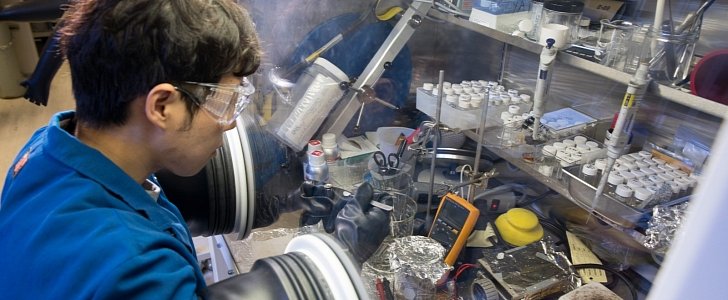In the quest to find more efficient and eco-friendly alternatives to standard lithium-ion batteries, researchers at IBM Research’s Battery Lab have come up with the recipe for a battery that has a higher power and energy density, a longer life, a lower cost and improved efficiency.
To put it simply, this battery is everything that the lithium-ion is not. Given the current trend pushing for all-electric everything, the applicability of the new battery is immense: from electric vehicles and aircraft, to smart power grid applications.
The focus behind the research was to come up with a battery that could “alleviate environmental concerns,” considering that lithium-ion batteries use heavy metals that are damaging to the environment because they’re obtained from mining – sometimes with humanitarian risks. They are also finite resources, so with increased demand for EVs, the need to come up with an alternative is pressing.
So, while lithium-ion batteries use lithium, manganese, cobalt and nickel, the new battery obtained in the IBM labs would source seawater for the 3 proprietary materials needed. No other materials that would pose sourcing concerns are used.
And that’s just the tip of the iceberg. Scientists estimate an 80 percent charge could be obtained in as little as 5 minutes without compromise to the specific discharge capacity. That would certainly alleviate concerns over long waiting times to charge your EV before you can go back on the road.
Because the materials are extracted from seawater, the new battery would be cheaper but that wouldn’t impact on quality. Scientists believe it would have a longer lifespan than lithium-ion counterparts, while also coming with low flammability, something which the lithium-ion does not have and which has been duly documented in the media.
“This design uses a cobalt and nickel-free cathode material, as well as a safe liquid electrolyte with a high flash point,” IBM says on the IBM Research Blog. “This unique combination of the cathode and electrolyte demonstrated an ability to suppress lithium metal dendrites during charging, thereby reducing flammability, which is widely considered a significant drawback for the use of lithium metal as an anode material.”
In lab tests, the new battery has shown to have high power density (over 10,000 W/L), high energy density (over 800 Wh/L) and excellent energy efficiency (over 90 percent), which would make it outperform the lithium-ion in literally every aspect.
IBM has partnered with several trade bodies, including Mercedes-Benz Research and Development, to take the research into the next stage, and “create a new next-generation battery development ecosystem.” For the time being, though, plans are in an “exploratory stage,” so it might be a while until this battery becomes widely available.
The focus behind the research was to come up with a battery that could “alleviate environmental concerns,” considering that lithium-ion batteries use heavy metals that are damaging to the environment because they’re obtained from mining – sometimes with humanitarian risks. They are also finite resources, so with increased demand for EVs, the need to come up with an alternative is pressing.
So, while lithium-ion batteries use lithium, manganese, cobalt and nickel, the new battery obtained in the IBM labs would source seawater for the 3 proprietary materials needed. No other materials that would pose sourcing concerns are used.
And that’s just the tip of the iceberg. Scientists estimate an 80 percent charge could be obtained in as little as 5 minutes without compromise to the specific discharge capacity. That would certainly alleviate concerns over long waiting times to charge your EV before you can go back on the road.
Because the materials are extracted from seawater, the new battery would be cheaper but that wouldn’t impact on quality. Scientists believe it would have a longer lifespan than lithium-ion counterparts, while also coming with low flammability, something which the lithium-ion does not have and which has been duly documented in the media.
“This design uses a cobalt and nickel-free cathode material, as well as a safe liquid electrolyte with a high flash point,” IBM says on the IBM Research Blog. “This unique combination of the cathode and electrolyte demonstrated an ability to suppress lithium metal dendrites during charging, thereby reducing flammability, which is widely considered a significant drawback for the use of lithium metal as an anode material.”
In lab tests, the new battery has shown to have high power density (over 10,000 W/L), high energy density (over 800 Wh/L) and excellent energy efficiency (over 90 percent), which would make it outperform the lithium-ion in literally every aspect.
IBM has partnered with several trade bodies, including Mercedes-Benz Research and Development, to take the research into the next stage, and “create a new next-generation battery development ecosystem.” For the time being, though, plans are in an “exploratory stage,” so it might be a while until this battery becomes widely available.















